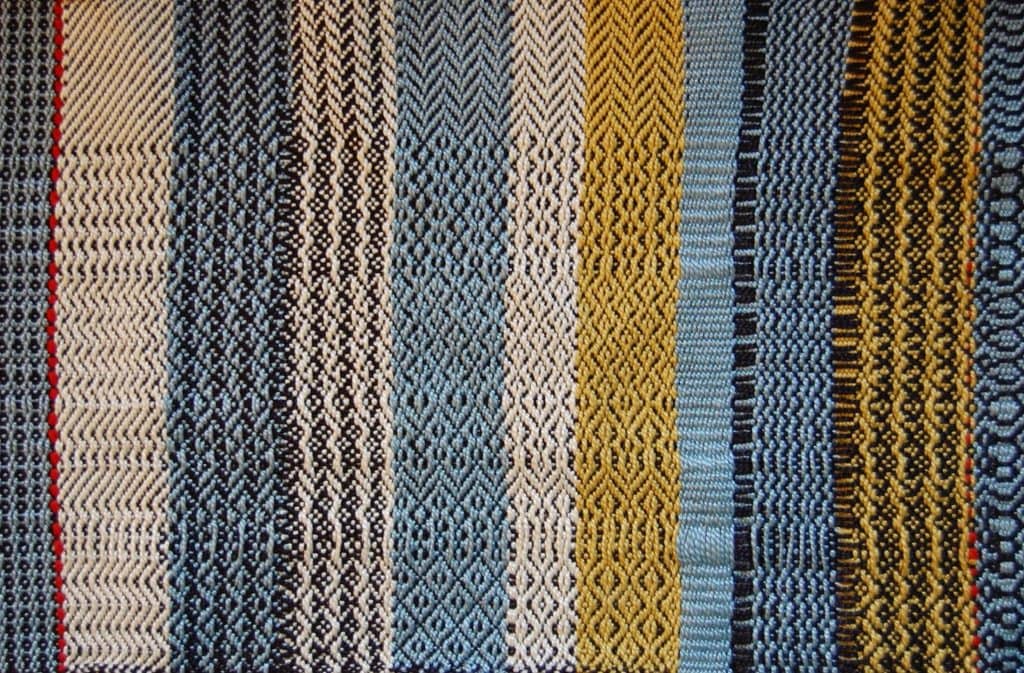By Melissa Ludden Hankens
A sampler is all about experimenting, in this case with twill weaves. After you are comfortable with plain weave, twill is a natural place to progress. With plain weave and twill under your belt, your weaving options are without end.
Melissa's Twill Sampler
What is twill? Close your eyes and visualize a piece of plain weave fabric. Your weft thread is going over and under each warp thread across the width.

Now, to weave twill, imagine that your weft thread is going over and under two warp threads at a time. The pairs of warp threads have nothing keeping them apart, so of course they’re going to snuggle up close. For a twill, your pattern will step over to create a diagonal line. In the draft below, is one example of a simple twill. Starting with the top row with blue horizontal lines, you can see that the first row weaves under 2 warps and then over 2 warps, repeat. Then, for the second row, the weft travels over first over 1 warp then repeats under 2 over 2 rest of the way across the warp. You can see that the next row steps over again. A twill fabric will be denser and more flexible than a plain weave fabric. A twill also needs to be more closely set than a plain weave fabric. You'll see by exploring the resources below that the possibilities of twill are vast.

Weaving Twill
Let’s talk about looms. At least three shafts (often also referred to as harnesses), are required to weave twill. A shaft loom, such as any of Schacht’s Table, Wolf, or Standard Floor Looms, is the perfect tool. When choosing a loom, consider your space as well as what kind of items you think you might like to spend most of your time weaving. The Wolf looms come in a range of widths and handily fold up—a great space saver for someone like me who lives in a smaller house.
There are several great references to consider reading before you get started.
Learning to Weave by Deborah Chandler, Interweave Press, Loveland, CO, 1995
This is a great introduction to twill that explains the process in simple terms.
Lesson 7 Basic Twills, p. 129 - 136
A Handweaver’s Pattern Book by Marguerite Porter Davison, John Spencer, Inc., Chester, PA, 1944
While there isn’t much instruction here, there are many, many patterns to keep you occupied at your loom. Ms. Davison’s drafts are written for a sinking shed loom, but Schacht shaft looms are all rising shed looms—your warp threads are pulled up when you treadle. To compensate, tie up the white spaces instead of the x-marked spaces. If you forget to do this, your pattern will be woven on the underside of the fabric. Simply flip your fabric over once it’s off the loom and you’re in business.
Chapter I Twill Treadlings, p. 1 – 10, Chapter II Bird’s Eye & Rose Path, p. 11 – 22, Chapter III Modified Twills, p. 23 – 32, Chapter IV Twill Combinations, p. 33 - 46
The Weaving Book: Patterns & Ideas by Helene Bress, Flower Valley Press, Gaithersburg, MD, 2009
For those who prefer a more theoretical approach to weaving, this is a great text.
Chapter 2 Twill, p. 39 - 198
You might also enjoy reading this online monograph, Twill Weaves and Derivatives at http://handweaving.net. A search for “twill” on handweaving.net will give you an extensive list of reading material.
In the next part of this series, I'll explore several different twill weaves.

